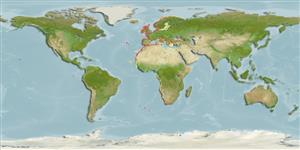Common names from other countries
Classification / Names / Names
Namen | Synonyme | Catalog of Fishes (gen., sp.) | ITIS | CoL | WoRMS
Environment: milieu / climate zone / depth range / distribution range
Ökologie
Demersal; süßwasser; brackwasser; tiefenbereich 0 - 29 m (Ref. 125465). Temperate; ? - 30°C (Ref. 125465)
Atlantic, Black Sea and the Mediterranean. Temperate to subtropical.
Length at first maturity / Size / Gewicht / Alter
Maturity: Lm ? range ? - ? cm
Known from depths of 0 to <50 m. Euryhaline. May tolerate freshwater conditions. Found in shallow brackish and estuarine waters, sometimes offshore; shows diurnal vertical migrations (Ref. 85342).
Life cycle and mating behavior
Geschlechtsreife | Fortpflanzung | Ablaichen | Eier | Fecundity | Larven
Members of the order Mysida are gonochoric. Mating behavior: Male inserts the penis into the marsupium and releases sperm; eggs are then released from the oviducts into the marsupium where fertilization occurs. Life cycle: Eggs are brooded in the marsupium and later hatch into miniature adults, no postlarva.
Healy, B. 1997. (Ref. 2779)
IUCN Rote Liste Status (Ref. 130435)
CITES Status (Ref. 108899)
Not Evaluated
Not Evaluated
Nutzung durch Menschen
| FishSource |
Tools
Mehr Information
Alter/Größe
Wachstum
Länge-Gewicht
Länge-Länge
Morphologie
Larven
Dichte
Internet Quellen
Estimates based on models
Preferred temperature
(Ref.
115969): 9.4 - 19.6, mean 14.2 (based on 833 cells).
Preiskategorie
Unknown.
